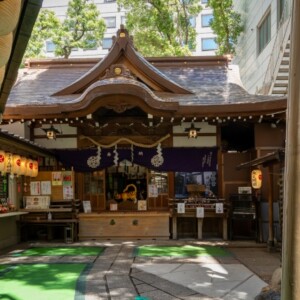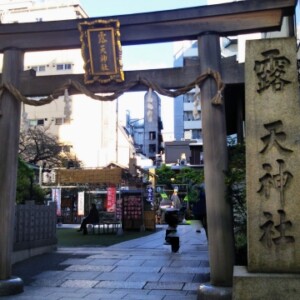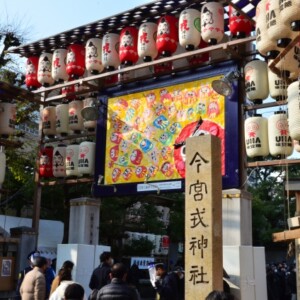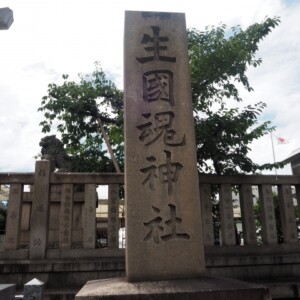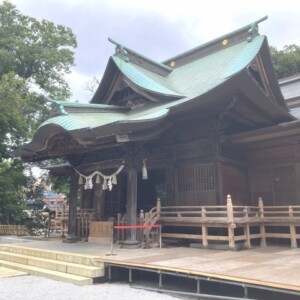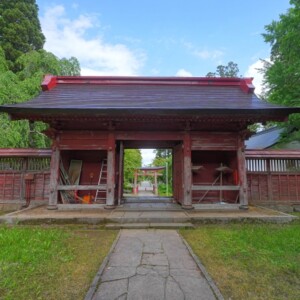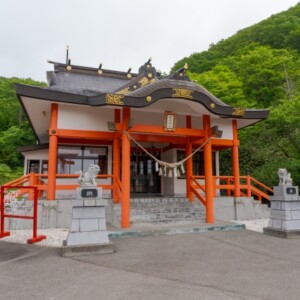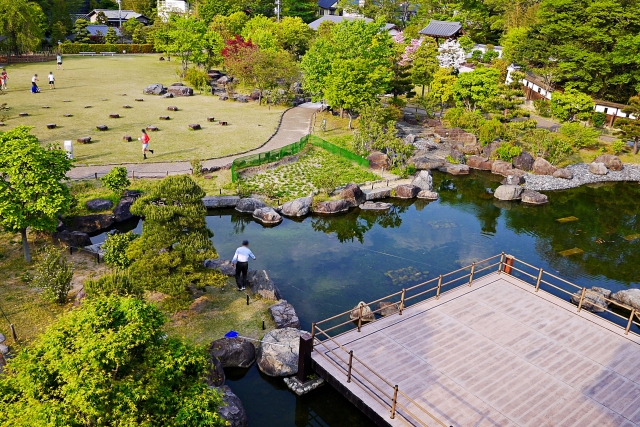
Ikeda Castle Ruins Park|Complete guide to the history, highlights, and usage of the park built at a strategic point during the Warring States period
Ikeda Castle Ruins Park, developed on the site of Ikeda Castle, which flourished as a strategic point during the Warring States Period, is a charming place for relaxation where history and nature are in harmony. The park continues to be loved by many as a special place where visitors can enjoy the spectacular view from the observation deck, the beautiful Japanese garden, and experience the tumultuous history of the Ikeda clan.
Ikeda Castle Ruins Park Overview and Basic Information
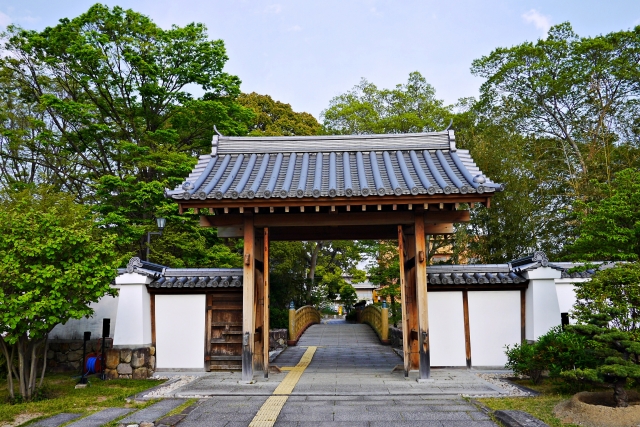
Ikeda Castle Ruins Park was developed to preserve and utilize for future generations the history of Ikeda Castle, which was the residence of the Ikeda clan, a local powerful family that ruled the Ikeda City area from the Muromachi Period to the Warring States Period. Opened in 2000, the park was reborn as a place where people of today can easily enjoy history and nature while preserving the historical value of the castle ruins.
History and Origin
Ikeda Castle is said to have been the residence of the Ikeda clan, national lords who ruled Toshima County (present-day Ikeda City, Toyonaka City, and Minoh City area) from the Muromachi Period to the Warring States Period. The exact date of construction is unknown, but it is said that Ikeda Kyoei built the castle around 1334 (the first year of the Kemmu Era).
The Ikeda clan was not a warring feudal lord but a local powerful family called Kuninin, but their economic power was immense, and they gained wealth through loan sharking and contracting out manor lands to local officials, and their economic power was comparable to that of the guardian feudal lords. Against this background, Ikeda Castle developed into one of the largest castles in the Kinai region.
Features of the Park and Outline of Facilities
Today, Ikeda Castle Ruins Park is a comprehensive historical park that includes a Japanese garden, a tea ceremony room with a tiled roof, a restoration corner of the castle ruins, and a rest house with a cairn-like observation deck. The garden was created by the Nakane Garden Research Institute, founded by Kinsaku Nakane, and is well known as the only pond garden in Ikeda City.
Admission to the garden is free, and the observation rest house located within the garden is wheelchair accessible, offering a panoramic view of not only the garden itself, but also the Ikeda city area, Big Harp, and Mt. The barrier-free design allows people of all ages to use the facility with peace of mind.
Highlights and Features of Ikeda Castle Ruins Park
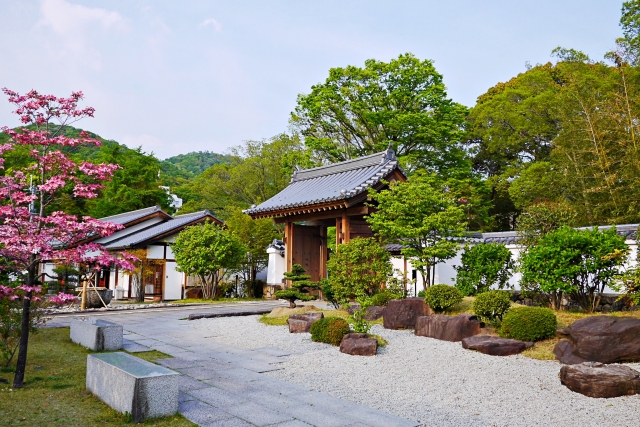
The charm of Ikeda Castle Ruins Park lies in the perfect harmony of historical remains and modern garden design. It is a luxurious space where visitors can feel the atmosphere of the Warring States period and enjoy the beautifully maintained Japanese garden and magnificent view at the same time.
Observation Rest House and Attraction of the View
The park’s central facility, the observation rest house, attracts visitors’ attention with its appearance resembling a castle keep. Visitors to Ikeda Castle Ruins Park can enjoy the castle keep-style rest house and garden. It is said that the attraction of such a garden is that you can look down on the garden from a high place, and you can look around as if you were a feudal lord.
The view from the observation deck is exceptional, with the New Inagawa Bridge (a.k.a. Big Harp), a cable-stayed bridge that looks like a giant harp, visible from far over the city, and on a clear day, even the direction of Kobe and Wakayama can be seen. The view of the mountains and cities of the Kansai region stretching beyond Ikeda City is a magnificent panorama reminiscent of the scenery seen by the lords of castles in the Warring States Period.
The Beauty of the Japanese Garden
When you go up to the keep-style observation rest house, you will see a pond garden with a suhama. In addition, a beautiful Japanese garden is developed with chestnut stones at the bottom of the pond. The design by Nakane Garden Research Institute is an outstanding work that utilizes traditional landscaping techniques while also providing modern functionality.
The garden is a pond garden structure, with a different expression for each season. Visitors can enjoy beautiful scenery throughout the four seasons: fresh greenery in spring, deep green shade in summer, autumn leaves in fall, and snowy landscape in winter. In particular, the panoramic view of the garden from the observation rest house is as beautiful as a painting.
History of Ikeda Castle and the Ikeda Clan
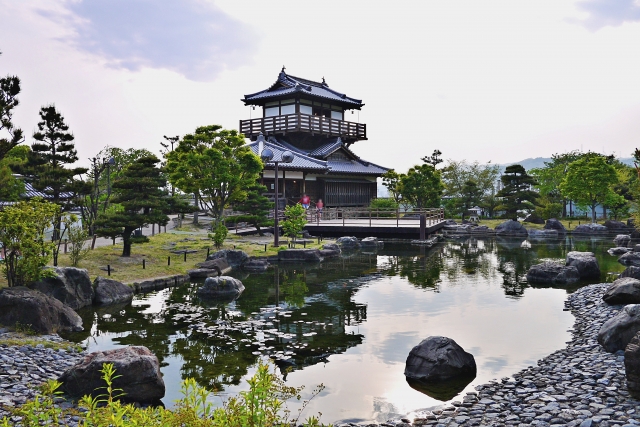
When visiting Ikeda Castle Ruins Park, visitors will be more deeply moved by learning about the rise and fall of the Ikeda clan and the turbulent history of the Warring States Period that unfolded in this area. The history of Ikeda Castle, which played an important role as a strategic point in the Kinai region, was full of vicissitudes that can be seen as a microcosm of Japan’s medieval history.
The Rise and Fall of the Ikeda Clan and Changes in the Castle
Ikeda Castle is located on a 50-meter-high hill near Shiroyama-cho, Ikeda City, Osaka Prefecture, and is known as one of the largest castles in the Kinai region, utilizing an east-west ridge at the southern foot of Mt. It was a fortress known as one of the largest castles in the Kinai region.
The history of the Ikeda clan has not been smooth. Although the castle was the residence of the Ikeda clan for generations, it belonged to the Eastern Army during the Onin War and was destroyed by an attack by the Western Army’s Ouchi Masahiro in 1469. Ikeda Castle was often exposed to war after that, and experienced turbulent times as the castle was repeatedly lost and recaptured by the Ikeda clan.
A particularly significant turning point in the history of Ikeda Castle came in 1508, when Sadamasa Ikeda, who belonged to the Hosokawa Sumimoto faction, was attacked by the opposing force, Takanori Hosokawa, and the castle fell. Excavations during this period have revealed thick deposits of charcoal layers and burnt earth, providing physical evidence that Ikeda Castle suffered severe warfare.
Araki Murashige and the Upheaval of the Warring States Period
One of the most dramatic periods in the Ikeda clan’s history was the period of subjugation by his vassal Araki Murashige. in 1568, Ikeda Katsumasa resisted Oda Nobunaga, but the castle was attacked by Oda’s forces and fell. However, Katsumasa was not blamed for resisting, and on the contrary, he was evaluated highly, and Nobunaga gave him 60,000 koku and made him a vassal.
However, Katsumasa was appointed by Nobunaga as one of the three Settsu guardians and served as a lord at the retreat of Kanegasaki, but was expelled from Ikeda Castle by his family members Ikeda Tomomasa and Araki Murashige, who had joined the Miyoshi Sanjinshu. Araki Murashige emerged as one of the “Ikeda 21,” a group of chief vassals, and organized the castle in a coup within the Ikeda clan that ousted Ikeda Katsumasa, and took control of Ibaraki Castle and Takatsuki Castle by defeating the three remaining Settsu guardians, Wada Tadamasa and Itami Chikanoki.
Murashige’s power expanded remarkably, and after acquiring Itami Castle, he renamed it Arioka Castle and moved his residence to Arioka Castle, thus Ikeda Castle was abandoned in 1574. In 1578, Murashige rebelled against Oda Nobunaga, leading to the Battle of Arioka Castle.
Visiting Guide
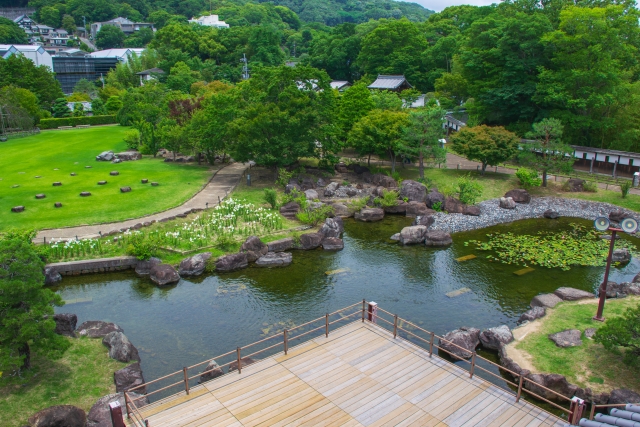
At Ikeda Castle Ruins Park, you can spend quality time learning about the history and enjoying the beautiful gardens and spectacular views. Please make your visit more meaningful by learning about the seasonal attractions and ways to enjoy them.
How to enjoy a stroll through the garden and the view
For a stroll through the garden, the first major entrance is the East Gate adjacent to the Education Center. Crossing a 3-meter-wide, 23-meter-long wooden bridge and passing through the gate, it is best to understand the structure of the garden, which is dotted with a Japanese garden, a teahouse based on a tiled roof, a restoration corner of the remains, and a yagura-style observation rest house.
In the observation rest house, visitors can learn the value of the castle ruins and the beauty of the garden at the same time by viewing an exhibition on the history of Ikeda Castle. Volunteer guides are available on weekends and holidays, so a weekend visit is recommended if you want to hear a more detailed explanation.
The time required to visit the garden varies according to the individual, but visitors who wish to take a leisurely stroll and enjoy the view from the observation deck should allow about one hour for a visit. The garden has a different appearance in each of the four seasons, so you will find something new no matter how many times you visit.
Annual and Seasonal Events
Ikeda Castle Ruins Park hosts a wide variety of events, including Ikeda Castle Ruins Park-sponsored events, picture books on the lawn, a photography school, yoga on the lawn, and the Hakubutsu Lily Festival. These events take advantage of the seasonal attractions and historical environment, and are popular among local residents as well as tourists.
The White Lily Festival, in particular, is one of the park’s representative events, allowing visitors to enjoy the special harmony of beautiful flowers and the historical atmosphere. The park also offers a variety of modern activities, such as yoga experiences on the lawn and a photography school, making it possible to use the park for a variety of purposes.
Detailed event information is updated on the official website from time to time, so it is recommended to check before visiting.
Access/Use Information
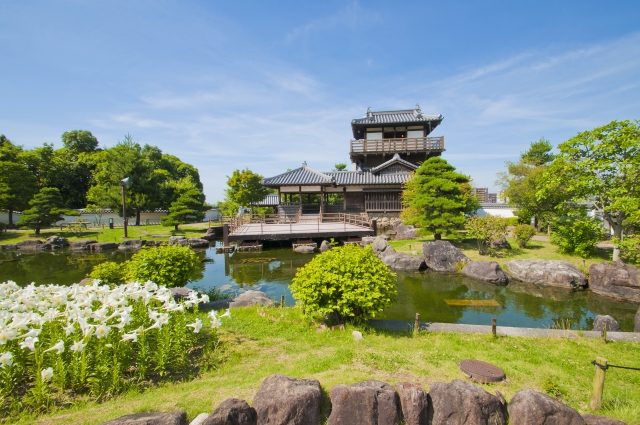
Ikeda Castle Ruins Park is conveniently accessible by both public transportation and automobile. It is within easy visiting distance of Osaka City, making it an ideal place for a day trip to explore history.
Transportation Access
When using public transportation, Ikeda is very accessible, taking approximately 20 minutes by Hankyu train from Umeda, Osaka. It is a 13-minute walk from Ikeda Station on the Hankyu Takarazuka Main Line or a 15-minute walk from Ikeda Station on the Hankyu Railway.
If you use the bus, you can also take a 6-minute walk from the “Gogatsuyama Park, Daikoji” bus stop on the bus route from IshibashiHandai-mae Station or Ikeda Station. This bus route is convenient when visiting in combination with nearby tourist attractions such as the Gotsukiyama Zoo.
The park is also easily accessible by car from the Chugoku-Ikeda IC of the Chugoku Expressway or the Hanshin Expressway. However, there is no parking lot dedicated to the park, so you will need to use the Mayakizan Ryokuchi Parking Lot (fee required).
Opening hours, fees, and parking information
Opening hours vary depending on the season: 【April-Oct】9:00 – 19:00, 【November-March】9:00 – 17:00. Closed: Tuesdays (if Tuesday is a national holiday, the park will be open on Tuesday and closed the following day) and during the year-end and New Year holidays.
Admission is free for the use of the park, allowing visitors to enjoy history and nature in a casual manner. However, pets are not allowed in the park, so visitors should refrain from visiting with their pets.
Parking is available at the Maytagoyama Ryokuchi Parking Lot, which charges 300 yen for one hour and 100 yen for every 20 minutes thereafter. The park is within walking distance from the parking lot, and visitors can also enjoy the nearby Gogetsuyama Zoo and other attractions.
<Address> 3-46 Shiroyamacho, Ikeda-shi, Osaka 563-0052
Reference site
Ikeda Castle Ruins Park Official Website: https://ikedashiroato.com/
Ikeda Castle Ruins Park official site: https://www.city.ikeda.osaka.jp/soshiki/toshiseibibu/midorinosei/shisetsu/1415931764666.html
Ikeda City Tourist Association Official Website: https://www.ikedashi-kanko.jp/spot/recommend-spot05



